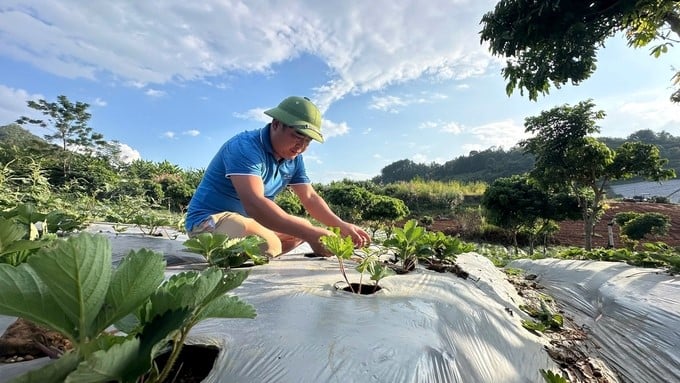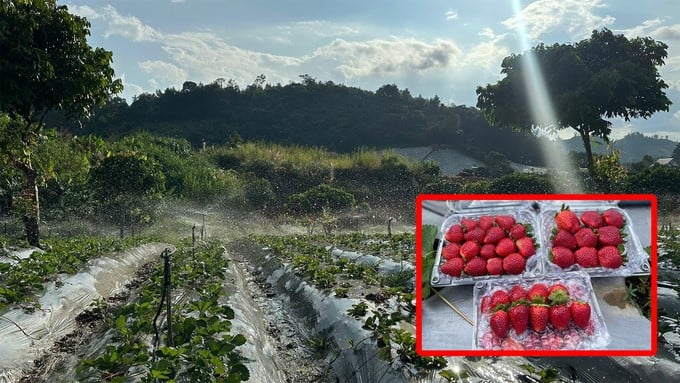November 23, 2025 | 19:16 GMT +7
November 23, 2025 | 19:16 GMT +7
Hotline: 0913.378.918
November 23, 2025 | 19:16 GMT +7
Hotline: 0913.378.918
"With such wonderful natural conditions, it would be a waste if not developing strawberry plants," Mr. Nguyen Van Nam, Director of Xuan Que Strawberry Cooperative, opened the story when sharing about Mai Son strawberry.
The climate is favorable, with a day and night temperature difference of about 10 oC. The temperature in the daytime is 28 oC, while it decreases to only 18 oC at night. The altitude is 790 to 900 m above sea level, combined with fertile soil and a high pH. These are prerequisites to helping strawberry plants grow well and produce sweet fruits.
In 2016, Mr. Nam started growing strawberries on a small scale, only on an area of about 5,000 m2 and with 16,000 plants. In that crop, he harvested 10 tons of strawberries at a selling price of VND 60,000/kg. The total initial investment is VND 240 million, including the cost of seedlings (about VND 5,000/tree), an automatic irrigation system (VND 20 million), and mulch to help control weeds and maintain humidity.
Thanks to scientific farming methods, Mr. Nam earned a profit of nearly VND 400 million after just one year. This convinced people in the village to join him in establishing Xuan Que Strawberry Cooperative to expand production scale.

Mr. Nguyen Van Nam, Director of Xuan Que Strawberry Cooperative, wishes to export Mai Son strawberries. Photo: Duc Binh.
One of the important factors that helps the Cooperative's strawberries achieve good quality is the application of modern farming techniques. Seedlings are carefully cared for in the greenhouse to avoid being affected by pests and harsh weather. When the seedlings develop reliably, usually around the end of April, they will be planted outdoors.
Before planting, the soil was furrowed and covered with plastic mulch. About a week after planting, humus solution is used to water the roots to stimulate root growth. After that, the plants continue to be fertilized with organic fertilizer combined with shrimp and fish protein to provide adequate nutrition.
According to Dr. Cao Van Chi, Deputy Director in charge of the Center for Citrus Research and Development (Fruit and Vegetable Research Institute), humus solution is a natural biological stimulant derived from decomposed organic matter, such as humus, peat, or sediment, and used to stimulate root growth without affecting plant health.
At the flowering stage, the Cooperative uses organic fertilizer at a reasonable rate to adjust the growth process, stimulate flowering, and produce fruits quickly. When fruiting, the frequency of fertilization is increased to every 5 days, helping the fruit grow evenly and reach optimal size. After harvesting, the plants continue to be fertilized to recover and prepare for the next crop.
The automatic irrigation system helps save water and ensure the necessary humidity for the plants. With the frequency of operation of twice a day, water is taken from drilled wells into large tanks, from which water is evenly distributed throughout the strawberry furrows. On rainy days, the gutter system is designed to drain water effectively, avoiding flooding.

Xuan Que Strawberry Cooperative is gradually affirming its reputation in Son La province thanks to the synchronous application of advanced technical solutions in farming. Photo: Duc Binh.
Currently, with a scale of 50 hectares, Xuan Que Strawberry Cooperative harvests 900-1,000 tons of strawberries each year. With an average price of VND 50,000/kg, the Cooperative's revenue reaches about VND 12 billion/year, and profit per hectare can be up to VND 500 million.
Strawberries grown in Mai Son are not inferior to Moc Chau strawberries in quality. Strawberries are large in size and have stable sweetness thanks to the large difference in day and night climate conditions. "The unfortunate thing is that the Mai Son Strawberry brand is not really widely recognized in the market," Mr. Nam shared.
In the immediate future, the Cooperative plans to invest in building a 2 ha greenhouse at a cost of about VND 5 billion to improve the production process and ensure stable product quality, thereby meeting the strict requirements for exporting strawberries.
In addition, the Cooperative is also promoting the development of agricultural tourism, bringing the strawberry farm into an attractive destination for tourists, not only helping to increase income but also promoting the image of Mai Son strawberry products.
In the future, the Cooperative will continue to expand production scale and perfect standards for export, making Mai Son Strawberry a big brand.
Translated by Thu Huyen

(VAN) The information was shared at the seminar 'Urban Agriculture - Solutions for Developing Green Spaces,' organized by the Kinh te & Do thi Newspaper and the Biotechnology Center of Ho Chi Minh City.
/2025/11/19/4141-2-132831_216.jpg)
(VAN) One of Japfa's outstanding solutions is implementing digital transformation and artificial intelligence (AI) to optimize operations, enhance productivity, and advance sustainable development.
/2025/11/19/4847-1-093540_448.jpg)
(VAN) The Gia Lai Provincial People’s Committee had a working session with the delegation of the U.S. Department of Agriculture, the State of Idaho, and representatives of the State's leading enterprises.

(VAN) Ca Mau has a sufficient foundation to become a strong regional aquaculture center, where production integrates the economy, the environment, and the lives of the people.

(VAN) SEIKI Group envisions itself as a pioneer in the ‘dual transformation’ of digital technology and green industry, standing alongside the Government and Vietnamese businesses in their pursuit of sustainable development.

(VAN) The VNGEONET network affirms Viet Nam's progress in mastering digital space, providing a precise positioning data platform to serve socioeconomic development.
/2025/11/14/3247-1-184556_35.jpg)
(VAN) Thai Nguyen is methodically implementing digital transformation in the livestock sector, laying the foundation for a modern, transparent, and sustainable agriculture.